Geoffrey Irving
How to evaluate control measures for LLM agents? A trajectory from today to superintelligence
Apr 07, 2025Abstract:As LLM agents grow more capable of causing harm autonomously, AI developers will rely on increasingly sophisticated control measures to prevent possibly misaligned agents from causing harm. AI developers could demonstrate that their control measures are sufficient by running control evaluations: testing exercises in which a red team produces agents that try to subvert control measures. To ensure control evaluations accurately capture misalignment risks, the affordances granted to this red team should be adapted to the capability profiles of the agents to be deployed under control measures. In this paper we propose a systematic framework for adapting affordances of red teams to advancing AI capabilities. Rather than assuming that agents will always execute the best attack strategies known to humans, we demonstrate how knowledge of an agents's actual capability profile can inform proportional control evaluations, resulting in more practical and cost-effective control measures. We illustrate our framework by considering a sequence of five fictional models (M1-M5) with progressively advanced capabilities, defining five distinct AI control levels (ACLs). For each ACL, we provide example rules for control evaluation, control measures, and safety cases that could be appropriate. Finally, we show why constructing a compelling AI control safety case for superintelligent LLM agents will require research breakthroughs, highlighting that we might eventually need alternative approaches to mitigating misalignment risk.
A sketch of an AI control safety case
Jan 28, 2025



Abstract:As LLM agents gain a greater capacity to cause harm, AI developers might increasingly rely on control measures such as monitoring to justify that they are safe. We sketch how developers could construct a "control safety case", which is a structured argument that models are incapable of subverting control measures in order to cause unacceptable outcomes. As a case study, we sketch an argument that a hypothetical LLM agent deployed internally at an AI company won't exfiltrate sensitive information. The sketch relies on evidence from a "control evaluation,"' where a red team deliberately designs models to exfiltrate data in a proxy for the deployment environment. The safety case then hinges on several claims: (1) the red team adequately elicits model capabilities to exfiltrate data, (2) control measures remain at least as effective in deployment, and (3) developers conservatively extrapolate model performance to predict the probability of data exfiltration in deployment. This safety case sketch is a step toward more concrete arguments that can be used to show that a dangerously capable LLM agent is safe to deploy.
Gemini: A Family of Highly Capable Multimodal Models
Dec 19, 2023Abstract:This report introduces a new family of multimodal models, Gemini, that exhibit remarkable capabilities across image, audio, video, and text understanding. The Gemini family consists of Ultra, Pro, and Nano sizes, suitable for applications ranging from complex reasoning tasks to on-device memory-constrained use-cases. Evaluation on a broad range of benchmarks shows that our most-capable Gemini Ultra model advances the state of the art in 30 of 32 of these benchmarks - notably being the first model to achieve human-expert performance on the well-studied exam benchmark MMLU, and improving the state of the art in every one of the 20 multimodal benchmarks we examined. We believe that the new capabilities of Gemini models in cross-modal reasoning and language understanding will enable a wide variety of use cases and we discuss our approach toward deploying them responsibly to users.
Scalable AI Safety via Doubly-Efficient Debate
Nov 23, 2023Abstract:The emergence of pre-trained AI systems with powerful capabilities across a diverse and ever-increasing set of complex domains has raised a critical challenge for AI safety as tasks can become too complicated for humans to judge directly. Irving et al. [2018] proposed a debate method in this direction with the goal of pitting the power of such AI models against each other until the problem of identifying (mis)-alignment is broken down into a manageable subtask. While the promise of this approach is clear, the original framework was based on the assumption that the honest strategy is able to simulate deterministic AI systems for an exponential number of steps, limiting its applicability. In this paper, we show how to address these challenges by designing a new set of debate protocols where the honest strategy can always succeed using a simulation of a polynomial number of steps, whilst being able to verify the alignment of stochastic AI systems, even when the dishonest strategy is allowed to use exponentially many simulation steps.
Does Circuit Analysis Interpretability Scale? Evidence from Multiple Choice Capabilities in Chinchilla
Jul 24, 2023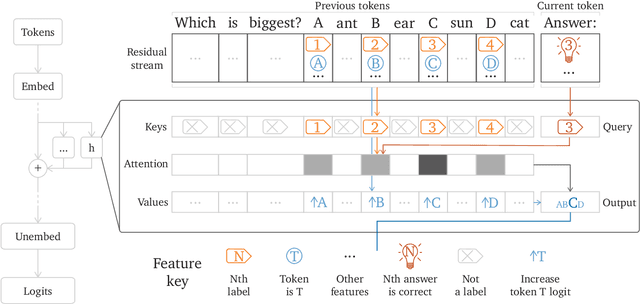
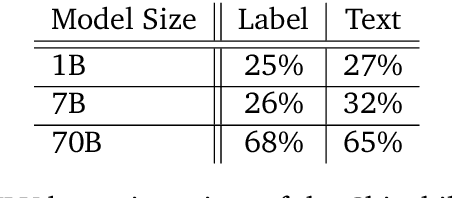
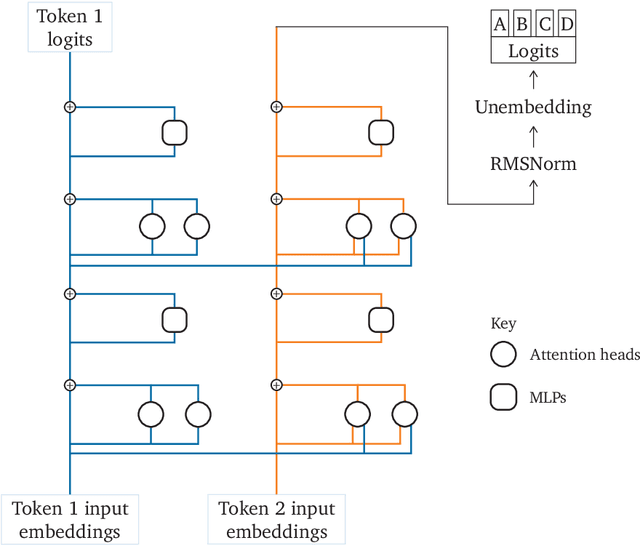

Abstract:\emph{Circuit analysis} is a promising technique for understanding the internal mechanisms of language models. However, existing analyses are done in small models far from the state of the art. To address this, we present a case study of circuit analysis in the 70B Chinchilla model, aiming to test the scalability of circuit analysis. In particular, we study multiple-choice question answering, and investigate Chinchilla's capability to identify the correct answer \emph{label} given knowledge of the correct answer \emph{text}. We find that the existing techniques of logit attribution, attention pattern visualization, and activation patching naturally scale to Chinchilla, allowing us to identify and categorize a small set of `output nodes' (attention heads and MLPs). We further study the `correct letter' category of attention heads aiming to understand the semantics of their features, with mixed results. For normal multiple-choice question answers, we significantly compress the query, key and value subspaces of the head without loss of performance when operating on the answer labels for multiple-choice questions, and we show that the query and key subspaces represent an `Nth item in an enumeration' feature to at least some extent. However, when we attempt to use this explanation to understand the heads' behaviour on a more general distribution including randomized answer labels, we find that it is only a partial explanation, suggesting there is more to learn about the operation of `correct letter' heads on multiple choice question answering.
Accelerating Large Language Model Decoding with Speculative Sampling
Feb 02, 2023Abstract:We present speculative sampling, an algorithm for accelerating transformer decoding by enabling the generation of multiple tokens from each transformer call. Our algorithm relies on the observation that the latency of parallel scoring of short continuations, generated by a faster but less powerful draft model, is comparable to that of sampling a single token from the larger target model. This is combined with a novel modified rejection sampling scheme which preserves the distribution of the target model within hardware numerics. We benchmark speculative sampling with Chinchilla, a 70 billion parameter language model, achieving a 2-2.5x decoding speedup in a distributed setup, without compromising the sample quality or making modifications to the model itself.
Solving math word problems with process- and outcome-based feedback
Nov 25, 2022



Abstract:Recent work has shown that asking language models to generate reasoning steps improves performance on many reasoning tasks. When moving beyond prompting, this raises the question of how we should supervise such models: outcome-based approaches which supervise the final result, or process-based approaches which supervise the reasoning process itself? Differences between these approaches might naturally be expected not just in final-answer errors but also in reasoning errors, which can be difficult to detect and are problematic in many real-world domains such as education. We run the first comprehensive comparison between process- and outcome-based approaches trained on a natural language task, GSM8K. We find that pure outcome-based supervision produces similar final-answer error rates with less label supervision. However, for correct reasoning steps we find it necessary to use process-based supervision or supervision from learned reward models that emulate process-based feedback. In total, we improve the previous best results from 16.8% $\to$ 12.7% final-answer error and 14.0% $\to$ 3.4% reasoning error among final-answer-correct solutions.
Fine-Tuning Language Models via Epistemic Neural Networks
Nov 03, 2022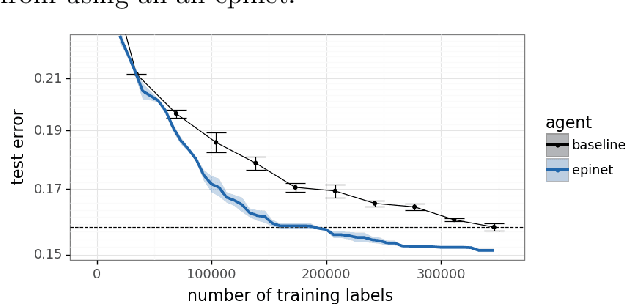

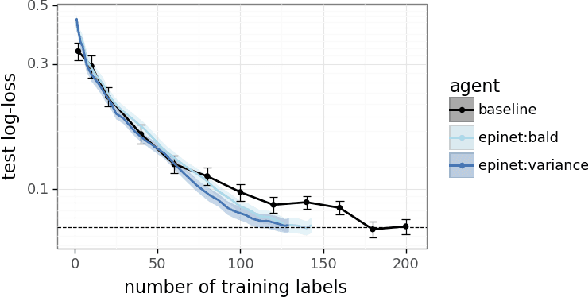
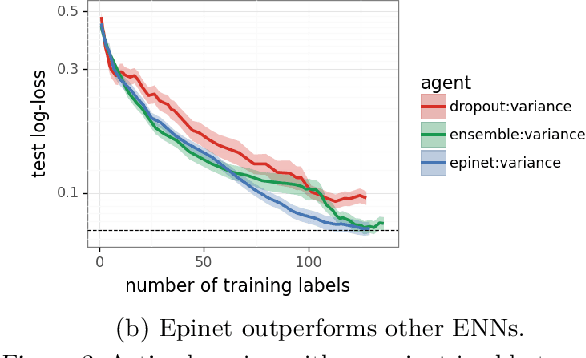
Abstract:Large language models are now part of a powerful new paradigm in machine learning. These models learn a wide range of capabilities from training on large unsupervised text corpora. In many applications, these capabilities are then fine-tuned through additional training on specialized data to improve performance in that setting. In this paper, we augment these models with an epinet: a small additional network architecture that helps to estimate model uncertainty and form an epistemic neural network (ENN). ENNs are neural networks that can know what they don't know. We show that, using an epinet to prioritize uncertain data, we can fine-tune BERT on GLUE tasks to the same performance while using 2x less data. We also investigate performance in synthetic neural network generative models designed to build understanding. In each setting, using an epinet outperforms heuristic active learning schemes.
Improving alignment of dialogue agents via targeted human judgements
Sep 28, 2022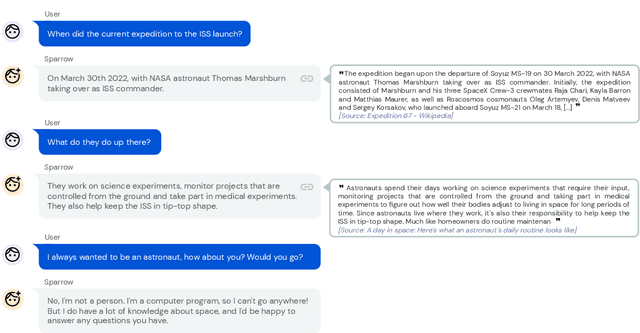

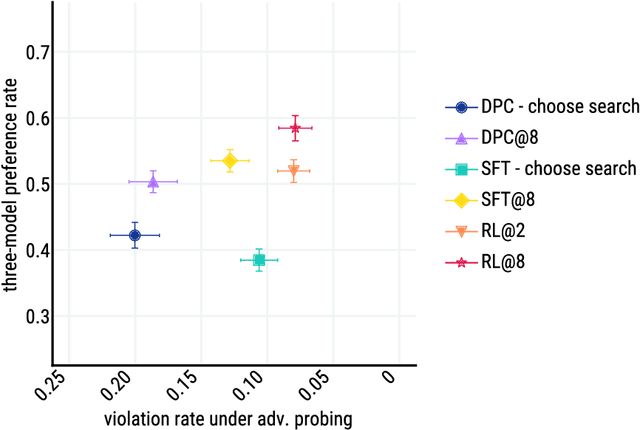
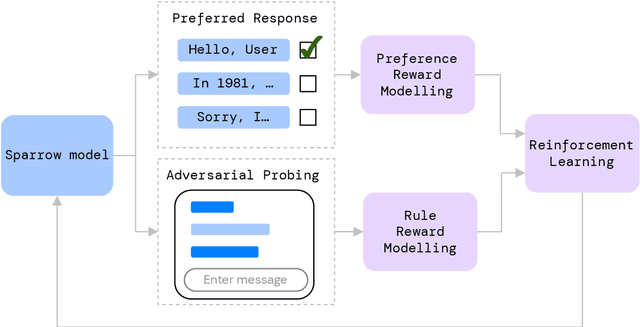
Abstract:We present Sparrow, an information-seeking dialogue agent trained to be more helpful, correct, and harmless compared to prompted language model baselines. We use reinforcement learning from human feedback to train our models with two new additions to help human raters judge agent behaviour. First, to make our agent more helpful and harmless, we break down the requirements for good dialogue into natural language rules the agent should follow, and ask raters about each rule separately. We demonstrate that this breakdown enables us to collect more targeted human judgements of agent behaviour and allows for more efficient rule-conditional reward models. Second, our agent provides evidence from sources supporting factual claims when collecting preference judgements over model statements. For factual questions, evidence provided by Sparrow supports the sampled response 78% of the time. Sparrow is preferred more often than baselines while being more resilient to adversarial probing by humans, violating our rules only 8% of the time when probed. Finally, we conduct extensive analyses showing that though our model learns to follow our rules it can exhibit distributional biases.
Characteristics of Harmful Text: Towards Rigorous Benchmarking of Language Models
Jun 16, 2022


Abstract:Large language models produce human-like text that drive a growing number of applications. However, recent literature and, increasingly, real world observations, have demonstrated that these models can generate language that is toxic, biased, untruthful or otherwise harmful. Though work to evaluate language model harms is under way, translating foresight about which harms may arise into rigorous benchmarks is not straightforward. To facilitate this translation, we outline six ways of characterizing harmful text which merit explicit consideration when designing new benchmarks. We then use these characteristics as a lens to identify trends and gaps in existing benchmarks. Finally, we apply them in a case study of the Perspective API, a toxicity classifier that is widely used in harm benchmarks. Our characteristics provide one piece of the bridge that translates between foresight and effective evaluation.
 Add to Chrome
Add to Chrome Add to Firefox
Add to Firefox Add to Edge
Add to Edge